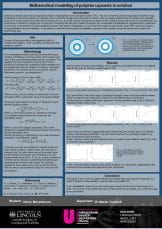By Henry Macpherson //
 The aim of the project was to explore the effect of including interdigitation in an existing model for the size selection of vesicles. Vesicles are shapes formed from a bilayer of amphiphiles (such as lipids and copolymers) which are often roughly spherical and can be used to house substances. Interdigitation is where the hydrophobic parts of both inner and outer layers are mixed. Vesicles can be potentially used for drug transportation in the body, if we know in what conditions a vesicle will assemble and break down. Knowing the preferred size of a vesicle in different conditions is key in determining how much of a material it could contain and could be used to control dosage in drug transportation.
The aim of the project was to explore the effect of including interdigitation in an existing model for the size selection of vesicles. Vesicles are shapes formed from a bilayer of amphiphiles (such as lipids and copolymers) which are often roughly spherical and can be used to house substances. Interdigitation is where the hydrophobic parts of both inner and outer layers are mixed. Vesicles can be potentially used for drug transportation in the body, if we know in what conditions a vesicle will assemble and break down. Knowing the preferred size of a vesicle in different conditions is key in determining how much of a material it could contain and could be used to control dosage in drug transportation.
I first had to get to grips with the existing paper by my supervisor on the topic, which meant reading up on the physics involved, as well as the numerical methods being utilised. I was then ready to see some of the code that we would be using. Getting up to speed on the surrounding theory was a slow process but, with plenty of guidance from my supervisor, it set me up to be more confident when performing calculations.
 Most of the time spent on the project involved using c++ to run code with various parameters and using the output data to explore the nature of the vesicles (or absence of vesicles) produced. Sometimes this involved plotting a graph and looking at its shape and sometimes this meant scouring test files for non-physical values. There were a few lines in the code that had to be tweaked to get accurate results, and this presented a real challenge to me early on. By the end, however, I felt confident in diagnosing issues and finding the right adjustments.
Most of the time spent on the project involved using c++ to run code with various parameters and using the output data to explore the nature of the vesicles (or absence of vesicles) produced. Sometimes this involved plotting a graph and looking at its shape and sometimes this meant scouring test files for non-physical values. There were a few lines in the code that had to be tweaked to get accurate results, and this presented a real challenge to me early on. By the end, however, I felt confident in diagnosing issues and finding the right adjustments.
We started by recreating the graphs featured in the existing paper by my supervisor. This was challenging but, with the existing graphs on hand, I knew what I was looking for. The second task was to create similar graphs in the case of an interdigitated vesicle. There was not as much to go on, but I felt far more confident at this point.
Throughout the project, I had plenty of contact with my supervisor, which was invaluable. Thanks to a certain virus, nearly all correspondence was via email, but this didn’t impact the project as much as I feared it would. In fact, I’m thankful that I have had a chance to practice communicating in this way. I’m sure it will put me in good stead for any remote working I have to do in the future.
The project has given me a real insight into this area of research and given me a great amount of experience in independent working. It has also led me to discover the environments in which I am most productive. This is knowledge which I’m sure will be a massive help in my further university studies and beyond.
*To view Henry’s research poster and presentation recording, please click on the thumbnails below: 

